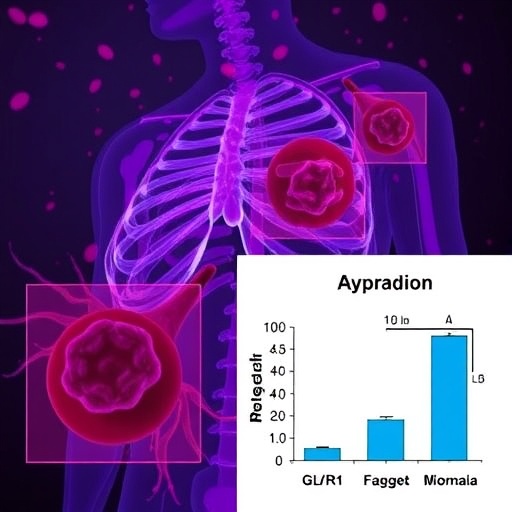In a groundbreaking advancement poised to reshape the landscape of multiple myeloma diagnosis and prognosis, recent research has illuminated the critical role of the poliovirus receptor (PVR) gene and protein levels alongside serum amylase and urinary biomarkers IGFBP-7 and TIMP-2. This comprehensive study, conducted by an international team of scientists and published in BMC Cancer in 2025, underscores the powerful potential of these biomarkers—not only to enhance early detection but to also stratify patient risk with unprecedented precision. By integrating molecular gene expression with protein quantification and bodily fluid analysis, the investigators have forged a multifaceted approach that may soon enter routine clinical practice, transforming how this complex plasma cell malignancy is managed worldwide.
Multiple myeloma (MM), a hematologic cancer characterized by malignant plasma cell proliferation in the bone marrow, carries substantial morbidity due to its systemic and renal complications. Despite advances in therapeutics, the heterogeneous nature of MM has challenged physicians in accurately predicting disease progression and tailoring individual treatment strategies. Recognizing this, the investigative team focused on biomarkers with compelling mechanistic links to MM pathophysiology, aiming to refine prognostic models beyond conventional clinical staging and cytogenetics. Their detailed analysis evaluated PVR gene expression and protein abundance along with serum amylase—a key enzymatic marker—and urinary IGFBP-7 and TIMP-2, both implicated in tissue remodeling and tumor microenvironment modulation.
Methodologically, the study employed a robust prospective design, enrolling 50 newly diagnosed MM patients alongside 50 age- and sex-matched healthy controls. The research protocol leveraged quantitative polymerase chain reaction (qPCR) for precise quantification of PVR gene expression in peripheral blood samples, while enzyme-linked immunosorbent assays (ELISA) measured PVR and amylase protein concentrations in serum. Concurrently, urinary levels of IGFBP-7 and TIMP-2 were determined through sensitive ELISA kits. This multi-analyte approach was coupled with advanced statistical techniques, including Kaplan-Meier survival curves, Cox proportional hazards modeling, and receiver operating characteristic (ROC) curve analysis, rigorously corrected for multiple comparisons using Bonferroni and false discovery rate (FDR) adjustments to minimize false positives.
The results illuminated striking differences between MM patients and controls across all biomarkers, with MM subjects exhibiting significantly elevated PVR gene expression and protein levels. This elevation correlated notably with advanced clinical staging and the presence of deleterious TP53 mutations, a marker of genomic instability and poor prognosis. Patients with high PVR expression demonstrated markedly reduced overall survival (OS), underscoring the receptor’s potential utility in identifying high-risk disease subsets. Concurrent elevations in serum amylase and urinary IGFBP-7 similarly predicted diminished OS and progression-free survival (PFS), indicating their independent prognostic value alongside PVR.
Intriguingly, multivariate analyses revealed that PVR expression, serum amylase, and IGFBP-7 levels each served as potent, independent predictors of patient outcomes. Hazard ratios exceeding 11 for these biomarkers highlight their strong association with mortality risk, a finding confirmed through rigorous bootstrapping and penalized regression techniques designed to ensure robustness in the face of complex data structures. Moreover, stratification into biomarker quartiles disclosed that individuals with the highest levels not only faced poorer prognosis but were also significantly enriched for TP53 mutations, reinforcing a close biological link between these markers and aggressive disease biology.
Beyond prognostication, the combined biomarker panel demonstrated exceptional diagnostic accuracy. ROC curve analysis revealed an area under the curve (AUC) of 0.97 when PVR, serum amylase, and urinary IGFBP-7 were assessed together, yielding sensitivity and specificity rates of 90% and 88%, respectively. This performance substantially outpaced individual biomarkers, suggesting their synergistic value as a noninvasive tool for MM detection. Such a panel could revolutionize current diagnostic algorithms, reducing reliance on invasive bone marrow biopsies and facilitating earlier intervention.
The inclusion of serum amylase, traditionally a marker of pancreatic function, in this biomarker ensemble is particularly notable. Its elevation in MM patients hints at broader systemic disturbances or paraneoplastic phenomena that merit further biological exploration. Similarly, IGFBP-7 and TIMP-2, known for their roles in extracellular matrix interactions and cellular signaling, offer new insights into the interplay between tumor cells and their microenvironment, potentially unveiling novel therapeutic targets.
Despite these promising findings, the authors acknowledge limitations inherent to their study. The single-center design and relatively modest sample size necessitate cautious interpretation, particularly regarding generalizability to diverse populations. Additionally, the absence of comparator groups comprising other hematologic malignancies restricts the ability to ascertain biomarker specificity. Importantly, the cross-sectional nature of biomarker measurement precludes dynamic assessment of changes over disease course or treatment response.
Looking forward, the research team advocates for large-scale, multi-institutional trials incorporating longitudinal sampling to validate and extend these findings. Such studies could refine biomarker thresholds, examine their predictive capabilities in the context of novel therapies, and test integration within clinical decision-making frameworks. Ultimately, the convergence of gene expression data with protein and fluid biomarker analytics represents a powerful paradigm shift in precision oncology for multiple myeloma.
The impact of this work cannot be overstated, as robust, noninvasive biomarkers constitute a crucial unmet need in MM management. By providing clinicians with tools to identify high-risk patients earlier and more accurately, therapeutic regimens can be optimized, potentially improving survival and quality of life. Furthermore, these biomarkers could facilitate the development of personalized medicine approaches that dynamically adjust therapy intensity, sparing patients unnecessary toxicity while aggressively targeting aggressive disease phenotypes.
From a scientific perspective, the elucidation of PVR’s role in MM biology opens exciting avenues for future research. Given PVR’s known involvement in immune checkpoint pathways and cell adhesion, understanding its modulation may also yield novel immunotherapeutic strategies. Concurrently, the intersection of metabolic enzyme dysregulation—as reflected by amylase levels—with cancer biology warrants deeper mechanistic studies.
In conclusion, this seminal study offers a compelling roadmap for biomarker-driven MM prognosis and diagnosis. By harnessing the combined power of PVR gene and protein measurements, serum amylase, and urinary IGFBP-7, clinicians stand on the brink of a new era in patient stratification and personalized care. While further validation is essential, these findings promise tangible improvements in the battle against multiple myeloma, bringing hope to patients and practitioners alike.
Subject of Research: Prognostic and diagnostic significance of PVR gene and protein levels, serum amylase, and urinary IGFBP-7 and TIMP-2 biomarkers in multiple myeloma.
Article Title: Prognostic and diagnostic value of PVR gene and protein levels, serum amylase, and urinary IGFBP-7 and TIMP-2 biomarkers in multiple myeloma.
Article References:
Habib, E.M., Hasan, A.M., Mohammed, S.A.A. et al. Prognostic and diagnostic value of PVR gene and protein levels, serum amylase, and urinary IGFBP-7 and TIMP-2 biomarkers in multiple myeloma. BMC Cancer 25, 873 (2025). https://doi.org/10.1186/s12885-025-14241-6
Image Credits: Scienmag.com
DOI: https://doi.org/10.1186/s12885-025-14241-6
Tags: comprehensive biomarker studyearly detection of hematologic cancersmolecular gene expression analysismultiple myeloma diagnosispatient risk stratification in cancerprognostic models in oncologyprotein quantification in cancer researchPVR gene and protein levelsserum amylase biomarkerTIMP-2 in multiple myelomatransforming multiple myeloma managementurinary biomarkers IGFBP-7





